|
|
|
Sort Order |
|
|
|
Items / Page
|
|
|
|
|
|
|
| Srl | Item |
| 1 |
ID:
152109
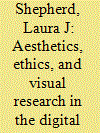

|
|
|
|
|
| Summary/Abstract |
Fifteen years ago, Roland Bleiker’s profound and influential article outlined a research agenda for those who take seriously the nature of aesthetic encounters with the social world. A rich and sophisticated literature addressing theoretical and methodological aspects of visual research in IR has emerged through the ‘aesthetic turn’ in International Relations (IR) theory.1 Efforts to theorise, or represent, global politics that are inspired by an aesthetic approach do not seek to produce the ‘most accurate’ theory or representation. ‘Approaching the study of IR with an aesthetic sensibility encourages scholars to pay analytical attention to affect rather than reason, judgement rather than fact, sensation rather than intellectualism’.
|
|
|
|
|
|
|
|
|
|
|
|
|
|
|
|
| 2 |
ID:
191056
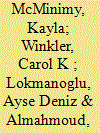

|
|
|
|
|
| Summary/Abstract |
Recognizing that militant, non-state groups utilize social media and online platforms to reach members, sympathizers, and potential recruits, state agencies and social media corporations now increasingly regulate access to accounts affiliated with such groups. Scholars examining deplatforming efforts have, to date, focused on the extent of audience loss after account restrictions and the identification of strategies for regrouping online followers on the same or different platforms over time. Left unexplored is if and how militant non-state groups adapt their official messaging strategies in response to platform restrictions despite continuing online access to them. To begin to fill that gap, this study compares ISIS’s 550 images displayed in the group’s official newsletter al-Naba six months before and after Europol’s November 2019 take-down of terrorist affiliated accounts, groups, channels, and bots on Telegram. It conducts a content analysis of images related to militaries and their outcomes, non-military activities and their outcomes, and presentational forms. The findings demonstrate that ISIS visually emphasizes its standard priming approach but shifts its agenda-setting strategy. While retaining some of its standard visual framing practices, the group also alters frames, particularly those related to images showing opposing militaries and military outcome.
|
|
|
|
|
|
|
|
|
|
|
|
|
|
|
|
| 3 |
ID:
152479
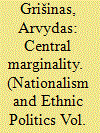

|
|
|
|
|
| Summary/Abstract |
The article discusses from an anthropological point of view the reasons why minorities tend to find themselves at the center of tensions in Central-Eastern Europe. It presents an idea that the answer to the question lays in the “human side” of the regional politics. In human experiential terms, the political “character” of the region and the image of ethnic minorities as political phenomena are both grounded in memory of suffering and victimization. Because of the historical and experiential circumstances, it became a basis for identity formation, perpetuating the regional tensions. However, such victimized identity can be hijacked and abused both by the actors themselves and the external forces.
|
|
|
|
|
|
|
|
|
|
|
|
|
|
|
|
| 4 |
ID:
173812
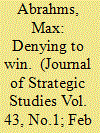

|
|
|
|
|
| Summary/Abstract |
Terrorism carries high audience costs for militant leaders because the attacks on civilians risk tarnishing the entire group as immoral extremists. Image-savvy militant leaders reduce the reputational fallout to the group whenever members commit terrorism. Specifically, the leaders distance their organization from civilian attacks by denying them. In this paper, I identify two types of denial strategies regularly employed by militant leaders, their effectiveness for image restoration, and how Islamic State paid a price for failing to employ them.
|
|
|
|
|
|
|
|
|
|
|
|
|
|
|
|
| 5 |
ID:
123063
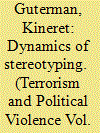

|
|
|
|
|
| Publication |
2013.
|
| Summary/Abstract |
This article considers popular ways of representing terror activists, and the metamorphoses that approaches to representation in the American media have undergone. A part of the article deals with terrorism in the media over time, common stereotypes, and how they affect the representation of Arabs and Muslims. The article then discusses Sleeper Cell (2005), a mini-series which focuses on a Jihad terror group. The article addresses questions including: How are Arabs and non-Arab Muslims portrayed in the series? Can a real change be observed over time in the method of portraying them? Twentieth-century historical considerations precede the pointed topical discussion.
|
|
|
|
|
|
|
|
|
|
|
|
|
|
|
|
| 6 |
ID:
124924
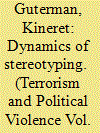

|
|
|
|
|
| Publication |
2013.
|
| Summary/Abstract |
This article considers popular ways of representing terror activists, and the metamorphoses that approaches to representation in the American media have undergone. A part of the article deals with terrorism in the media over time, common stereotypes, and how they affect the representation of Arabs and Muslims. The article then discusses Sleeper Cell (2005), a mini-series which focuses on a Jihad terror group. The article addresses questions including: How are Arabs and non-Arab Muslims portrayed in the series? Can a real change be observed over time in the method of portraying them? Twentieth-century historical considerations precede the pointed topical discussion.
|
|
|
|
|
|
|
|
|
|
|
|
|
|
|
|
| 7 |
ID:
079901
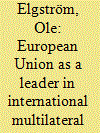

|
|
|
|
|
| Publication |
2007.
|
| Summary/Abstract |
This article analyses the leadership role of the European Union (EU) in international multilateral negotiations. The purpose is to problematize the role of the EU as a multilateral leader by contrasting its self-images as an active initiator with other negotiating actors' perceptions of the Union. This is done by comparing the role conceptions presented by EU representatives with the images presented by delegates from non-member states in three different multilateral negotiating contexts. My results present a picture of the EU as a `restricted leader'. The undisputable great power status that the EU is claimed to hold is not necessarily transformed into a leadership role. The causes vary: in two cases it is internal disunity and co-ordination problems that create obstacles to intellectual leadership; in the third case it is perceived role conflicts that make the EU less than credible in its leadership aspirations. The existing potential for structural leadership is therefore not translated into practice
|
|
|
|
|
|
|
|
|
|
|
|
|
|
|
|
| 8 |
ID:
123782
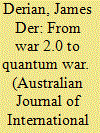

|
|
|
|
|
| Publication |
2013.
|
| Summary/Abstract |
As information networks catalyse local incidents into international crises, as global events appear and disappear on multiple screens at an accelerated pace and as a war of images displaces the image of war, it becomes increasingly difficult to understand the rapidly changing nature of global violence within the confines of security studies. Phase-shifting with each media intervention from states to sub-states, local to global, public to private, organised to chaotic and virtual to real-and back again-global violence superpositions into a quantum war that requires new transdisciplinary, transnational and transmedial approaches.
|
|
|
|
|
|
|
|
|
|
|
|
|
|
|
|
| 9 |
ID:
172426
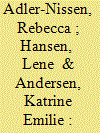

|
|
|
|
|
| Summary/Abstract |
How are images, emotions, and international politics connected? This article develops a theoretical framework contributing to visuality and emotions research in International Relations. Correcting the understanding that images cause particular emotional responses, this article claims that emotionally laden responses to images should be seen as performed in foreign policy discourses. We theorise images as objects of interpretation and contestation, and emotions as socially constituted rather than as individual ‘inner states’. Emotional bundling – the coupling of different emotions in discourse – helps constitute political subjectivities that both politicise and depoliticise. Through emotional bundling political leaders express their experiences of feelings shared by all humans, and simultaneously articulate themselves in authoritative and gendered subject positions such as ‘the father’. We illustrate the value of our framework by analysing the photographs of Alan Kurdi, a three-year-old Syrian-Kurdish boy who drowned in September 2015. ‘Kurdi’ became an instant global icon of the Syrian refugee crisis. World leaders expressed their personal grief and determination to act, but within a year, policies adopted with direct reference to Kurdi's tragic death changed from an open-door approach to attempts to stop refugees from arriving. A discursive-performative approach opens up new avenues for research on visuality, emotionality, and world politics.
|
|
|
|
|
|
|
|
|
|
|
|
|
|
|
|
| 10 |
ID:
153654
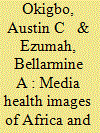

|
|
|
|
|
| Summary/Abstract |
This paper is an ethnomusicological and media studies collaborative study that discusses the politics of representation on media health images, especially HIV/AIDS in Africa, and how a South African AIDS support group and choral ensemble offers a counter-narrative to the images that are seen in the Western media. Using ethnographic data on the group’s organization, music events, and interviews with choir members, we argue that Siphithemba Choir’s story is a narrative of self-representation that subverts the appropriation of their story by the scientific community, and counters the helpless image of HIV-infected individuals that often comprise the face of HIV/AIDS in Africa in the mainstream media.
|
|
|
|
|
|
|
|
|
|
|
|
|
|
|
|
| 11 |
ID:
166660
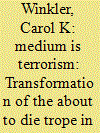

|
|
|
|
|
| Summary/Abstract |
Daesh’s ability to successfully recruit foreign fighters from more than one hundred countries worldwide raises the importance of understanding the group’s strategic media campaign. Recognizing that visual images, in particular, often increase viewers’ attention, recall, and emotional response, this study of Daesh’s official magazine, Dabiq, moves beyond earlier studies primarily focused on the magazine’s textual content to analyze the group’s visual communication strategy. This study’s content analysis of the 1,144 images appearing in the magazine’s first twelve issues reveals how Dabiq has relied extensively on a historic American media trope, the about to die image, to bolster image recirculation over time. This essay examines both the form and content of Dabiq’s use of three about to die image types as they have evolved across the twelve issues. Rather than seek to win the “hearts and minds” of the Muslim public, Dabiq’s use of about to die images transforms the online medium into terrorism in ways that have lasting implications for the global culture.
|
|
|
|
|
|
|
|
|
|
|
|
|
|
|
|
| 12 |
ID:
178125
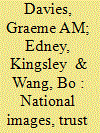

|
|
|
|
|
| Summary/Abstract |
This article uses a new dataset of Chinese student attitudes to foreign affairs to analyse how perceptions of the United States, Russia, Japan and North and South Korea affect respondent perceptions of international friendship with these states. Employing a mediation analysis we find that perceptions of national trustworthiness above all other images is the crucial factor in explaining cross-national friendship. These findings suggest that trust-building measures would be a fruitful avenue for both reducing the likelihood of conflict in the region and fostering cooperative international interactions.
|
|
|
|
|
|
|
|
|
|
|
|
|
|
|
|
| 13 |
ID:
109589
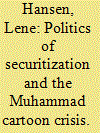

|
|
|
|
|
| Publication |
2011.
|
| Summary/Abstract |
A broad array of authors and schools have influenced Barry Buzan and Ole Wæver's formulation of securitization theory, including John L. Austin, Jacques Derrida and Carl Schmitt. This article draws attention to and strengthens the post-structuralist elements in the writings of Buzan and Wæver, as this part of the theory has received less attention than those attributable to Schmitt and Austin. Starting from securitization theory as developed by Buzan and Wæver and engaging with later expansions of the theory, I suggest a post-structuralist framework built around three questions: Through which discursive structures are cases and phenomena represented and incorporated into a larger discursive field? What is the epistemic terrain through which phenomena are known? And, what are the substantial modalities that define what kind of an issue a security problem is? The last part of the article brings this framework to bear on the 'Muhammad cartoon crisis' that began with the publication of 12 cartoons depicting the Prophet Muhammad in the Danish newspaper Jyllands-Posten in 2005.
|
|
|
|
|
|
|
|
|
|
|
|
|
|
|
|
| 14 |
ID:
171919
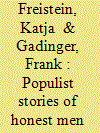

|
|
|
|
|
| Summary/Abstract |
This article proposes the methodological framework of visual narrative analysis through the study of images and narratives. We are interested in the appeal of political storytelling. In applying an approach of layered interpretation, we study images and slogans to consider the more complex underlying narratives in their political and cultural context. Our exploratory case studies draw on material from right-wing populist parties, namely election campaign posters from Germany and the UK as material for the analysis. We find that narratives operate with a ‘fantasmatic logic’, which adds fantasy to politics, to depoliticise and camouflage their radical intent and gain approval by making consent desirable. We identify two exemplary narratives (honest men under threat; proud mothers) that entrench traditional gender roles in accordance with patriarchy and nationalism. Theoretically, our approach contributes to debates in IR on cultural underpinnings in international politics and the construction of collective identities through shared/divided narratives. Visual narrative analysis provides a promising methodological tool for analysing visual representations in their productive relationship with text. This perspective foregrounds the power of political storytelling through fantasmatic appeal and fosters a better understanding of the global rise of populism.
|
|
|
|
|
|
|
|
|
|
|
|
|
|
|
|
| 15 |
ID:
124956
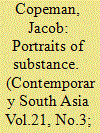

|
|
|
|
|
| Publication |
2013.
|
| Summary/Abstract |
This essay examines the way extractions of human blood - for medical donations, portrait paintings, and petitions - have come to form a significant means of political communication (particularly as a means of political protest) throughout India, focusing in particular on a case study from the south of a karate teacher and artist who, through painting multiple portraits of the Tamil Nadu Chief Minister with his blood, sought land for his karate school. The second half of the essay explores wider features of India's 'sanguinary politics', focusing in particular on ways in which publicly witnessed deployments of political activists' own blood once seemed to promise both intensification and purification of mass political idioms. It also considers how and why this promise has largely remained unfulfilled.
|
|
|
|
|
|
|
|
|
|
|
|
|
|
|
|
| 16 |
ID:
144170
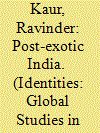

|
|
|
|
|
| Summary/Abstract |
This paper examines the aesthetics of remixing history at the heart of the neoliberal project of India’s image makeover as the ‘land of limitless opportunity’ for global tourists and investors. I argue that the project of remixing India’s history is predicated upon the ontological fault line of how to retain and erase the original simultaneously while shaping the new in the contemporary global. Taking the Incredible India campaign as an example, I show how the original essence of India is revealed and authenticated in the very moment of its disappearance as it is morphed in the aesthetics of the contemporary global. The post-exotic self, I further argue, is not produced by effacing the exotic past, but by condensing, accelerating and fast-forwarding it into a timeless, infinite global present. And in doing so, it also reveals the blueprint of the ongoing visual rearrangement of nation’s civilisational past in the making of new India.
|
|
|
|
|
|
|
|
|
|
|
|
|
|
|
|
| 17 |
ID:
153553
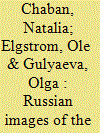

|
|
|
|
|
| Summary/Abstract |
This article probes into scope conditions for image change, investigating what changes in Russian images of the European Union (EU) have taken place as a result of the Russian–Ukrainian crisis. The crisis, a catalytic event, has been surrounded by uncertainty and strong emotions and is seen as a potential historical watershed in EU–Russian relations. The article examines Russia’s images of the EU’s intentions (good or bad?), capabilities (strong or weak?), and cultural and political status (inferior or superior?); and how they change in connection with the Russian–Ukrainian crisis. The article compares EU images across time found in Russian major newspapers and public opinion (studies undertaken in 2011–12 and 2015, before and after the crisis).
|
|
|
|
|
|
|
|
|
|
|
|
|
|
|
|
| 18 |
ID:
193012
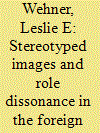

|
|
|
|
|
| Summary/Abstract |
Populist leaders unfold anti-elite rhetoric to sustain the ‘in-group’ morale of the ‘people’ they represent. Populist projects contain an ‘us’ versus ‘them’ dimension constituted by the stereotyped images that serve to inform the role-selection process in foreign policy. When images shaping roles on the international stage are used against the ‘out-group’, they become stereotypes of other actors. Therefore, this article explores how anti-pluralist populist leaders such as Jair Bolsonaro and Donald Trump use stereotyped images, and how these images – which speak to intention, affective tags and the evaluation of options – shape the foreign policy role behaviour of the states in question. The article develops a framework at the interplay of images and roles to analyse how these two aspects are used by the leader in an oversimplified manner to delineate boundaries between self and other, and thus to identify the membership base of the populist project versus those who are seen as a threat to their populist foreign policy.
|
|
|
|
|
|
|
|
|
|
|
|
|
|
|
|
| 19 |
ID:
103666
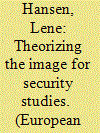

|
|
|
|
|
| Publication |
2011.
|
| Summary/Abstract |
This article provides a framework for the study of visual securitization, that is, when images constitute something or someone as threatened and in need of immediate defense or when securitizing actors argue that images 'speak security'. To study security politics is to focus on the public constitution of threats and dangers; to study visual securitization, therefore, requires an analysis not just of the image as a free-standing entity, but of the ways it is constituted through spoken and written discourse. To analyze the process of visual securitization, this article advances an inter-visual/intertextual model consisting of four components: the visual itself, its immediate intertextual context, the wider policy discourse, and the constitutions of the image. Three additional sets of theoretical arguments deepen this model by pointing to the specificity of the image as comprised through immediacy, circulability, and ambiguity, the strategies of depiction that images employ, and the genres through which images are brought to the audience. The applicability of the theoretical framework is illustrated through a case study of one of the most conspicuous cases of visual securitization: the Muhammad Cartoon Crisis.
|
|
|
|
|
|
|
|
|
|
|
|
|
|
|
|
| 20 |
ID:
126362
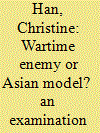

|
|
|
|
|
| Publication |
2013.
|
| Summary/Abstract |
This article compares the history curricula of Hong Kong and Singapore since the 1980s with respect to their treatment of Japan, particularly its involvement in World War II. It examines the role played by Japan as one significant "Other" against which its former victims define themselves. As well as being cast as a wartime aggressor and agent of local "victimhood," Japan has also been hailed as an economic and military model worthy of emulation. By comparing portrayals in school history textbooks and their shifts over time, the author shows how images of Japan have been used by state elites in these two former British colonies to construct significantly divergent official visions of "postcolonial" identity.
|
|
|
|
|
|
|
|
|
|
|
|
|
|
|
|
|
|
|
|
|